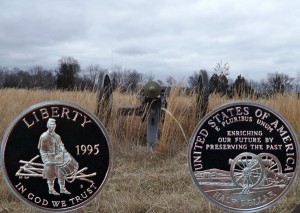The Civil War Battlefield Commemorative Half Dollar Coin remembers the activities near Chattanooga 151 years ago today.
In the Pittsburgh Gazette Times of November 24, 1913, an article titled The Civil War Fifty Years Ago described the battle:
=====
Second Day at Chattanooga
Fifty years ago today, in the second day’s fighting at Chattanooga, General W. T. Sherman secured a foothold on a commanding hill at the north end of Missionary Ridge, which was occupied by the Confederate Army under General Braxton Bragg, while General Joseph Hooker drove the extreme left of the Confederate line from the north slope of Lookout Mountain in the “battle above the clouds.”
Sherman’s force moved rapidly in three columns away from the river, following the direction of Chickamauga Creek toward Missionary Ridge. The day was rainy and almost before the Confederates were aware that the Federals were advancing in force from the river, Sherman’s skirmish lines were passing over the foothills to the north of Missionary Ridge. By the time Gen. Bragg’s officers on the right realized the extent of the menace, Sherman was in possession of a high hill directly north of the abrupt northern slope of Missionary Ridge.
The Confederates sought to dislodge him with artillery, but the Federal guns were soon brought into play, and the day closed on that part of the field with Sherman firmly in position and the ineffectual thunder of guns roaring in the misty valley between the two positions.
Sherman had gained important ground, but the result of the day was not what he had expected it to be. His maps had shown Missionary Ridge as a continuous chain, ending in an abrupt crest at the North. Instead of gaining that crest, he was on a detached ridge, with the main stronghold of the enemy yet to be assaulted.
Eight miles south of this scene of operations nightfall found the forces under Gen. Hooker contesting the ground on the northern shoulder of Lookout Mountain.
They had fought all day on the rough and rocky mountain slope. The enemy had been favored by the character of the ground and had disputed the Federal advance step by step.
The scene of operations was far below the palisaded crest of the mountain and between its cliffs and the river. The Federals had advanced from Lookout Valley on the west side of the mountain in the early morning. Their purpose was to sweep the Confederates from the shoulder of the mountain and open communication with the Federal line in front of Chattanooga.
Lookout Mountain was held by a Confederate force under General Carter L. Stevenson consisting of six brigades. One was on the top of the ridge, a mile and a half south of the shoulder of the mountain; two were in the valley to the east; and the shoulder of the mountain, over which the Federals aimed to advance was held by but two brigades. Another brigade held the west side of the slope with a picket line nearly two miles long.
A veil of mist obscured the valley from the Confederates in the morning. Gen. Hooker, who was on a hill in the valley, sent Geary’s command up Lookout Creek while the remainder of his men were bridging the creek in front of the enemy’s picket line. Geary crossed the creek unobserved and moved down its east bank along the steep side of the ridge, while the Confederates were engaged at the bridge.
Gen. Walthall had advanced his sharpshooters from their rough rifle pits along the rocky west face of the slope and kept up an effective fire upon the bridge. Geary was rolling up Walthall’s picket line from the south.
Under heavy fire from their batteries posted in Lookout Valley and on Moccasin Point, the Federals began slowly to climb the rough slope. The Confederates, hidden behind trees, stumps and boulders, fired until their assailants were within a few paces, then retreated. Often a handful of sharpshooters tarried too long for a final shot and found themselves prisoners.
By 1 o’clock the battle line had reached the open space of a farm known as Craven’s on the open slope and directly north of the crest. The Confederates had a line of rifle pits here, and for an hour or more they held them stubbornly. Only two brigades withstood the assaults of Hooker’s force aided as it was by the guns on Moccasin Point.
These two brigades continued their resistance with desperate tenacity. At 2 o’clock the fog was so dense as to cause darkness. The fighting continued until 9 in the evening when the Confederates retired, leaving the Federals in undisputed control of the mountain slope.
In the course of the night the Confederate troops on the mountain top were withdrawn, and in the morning the Stars and Stripes were raised on Pulpit Rock above the scene of the day’s fighting.
The misty brow of Lookout Mountain was visible to watchers in the valley at Chattanooga during the progress of the fighting on the slope under the crest. Among the officers who noted the progress of the fight was Quartermaster Gen. Montgomery C. Meigs.
Struck by its picturesque features, he wrote in an official report:
“The day had been one of driving mists and rain, and much of Hooker’s battle was fought above the clouds, which concealed him from our view, but from which the musketry was heard.
“At nightfall the sky cleared and the full moon, ‘the hunter’s moon,’ shown upon the beautiful scene. Till 1 am twinkling sparks upon the mountainside showed the picket skirmishing still going on, then it ceased. A brigade sent from Chattanooga opened communication with Hooker soon after nightfall.
“At day break on the 25th the Stars and Stripes were discerned on the peak of Lookout.”
=====
The Civil War Battlefield Commemorative Half Dollar Coin shows against a cannon in a Tennessee battlefield.
